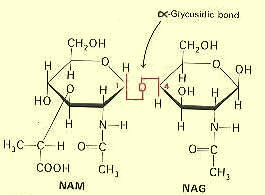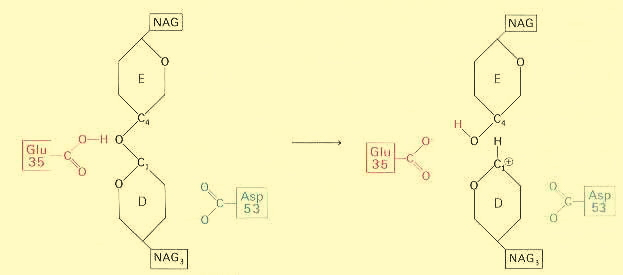Before getting into the reaction mechanism of lysozyme it important to review the structure of the ligand that lysozyme cleaves. Like pac man eating little white dots, lysozyme likes to much (catalyze) the reaction that breaks a specific polysaccharide apart. A polysaccharide is nothing more than the linking together of sugar residues to form a chain. The polysaccharide of lysozyme reaction is made up of N-acetylglucosamine (NAG) and N-acetylmuramic acid (NAM). NAM and NAG are joined together by glycosidic linkage. This linkage comes in two forms. Either as an alpha configuration where the linking oxygen comes from an OH group below the plane of the sugar ring (Fig 1) or a beta configuration where the oxygen comes from an OH group above the plane of the sugar ring (Fig 2) In figures 1 and 2, the linking oxygen between NAM and NAG comes from an OH- group on NAG. The type of bond that lysozyme cleaves is called a beta (1-4) NAM-NAG glycosidic bond. More accurately it is the glycosidic bond between the C-1 of NAM and the oxygen attached to the C-4 of NAG. [Stryer, 1981] The portion of the polysaccharide ligand that lysozyme binds to contains six alternating NAM and NAG rings labeled A through F.
The polysaccharide chains in the cell wall of bacteria are also linked together side by side to form an interlinked sheet. These side by side chains are held together via bonds between the N-acetylmuramic acid residues. Another ligand that is cleaved by lysozyme is chitin, which is found in the shells of crustaceans. Chitin does not have any NAM sugars but rather is made entirely of NAG sugars.
The reaction mechanism of human lysozyme occurs at its peak at a pH of 5.1. If the pH is lowered to 4.0, the rate drops 60%.[Song, 1994] The actual reaction mechanism that takes place is that a proton is transferred from the carboxyl group of Glu 35 to the bond between C-1 of the D ring and the glycosidic oxygen atom.(Fig. 3) This proton transfer results a carbonium ion forming on C-1 of the D ring. Aspartic acid 52 helps to stabilize the carbonium ion formed. Press to see where Glu 35 and Asp 52 are on the enzyme.
 Figure 1 Alpha glycosidic bond between NAM & NAG. [Stryer, 1981] |
 Figure 2 Beta glycosidic bond between NAM & NAG. [Stryer, 1981] |

